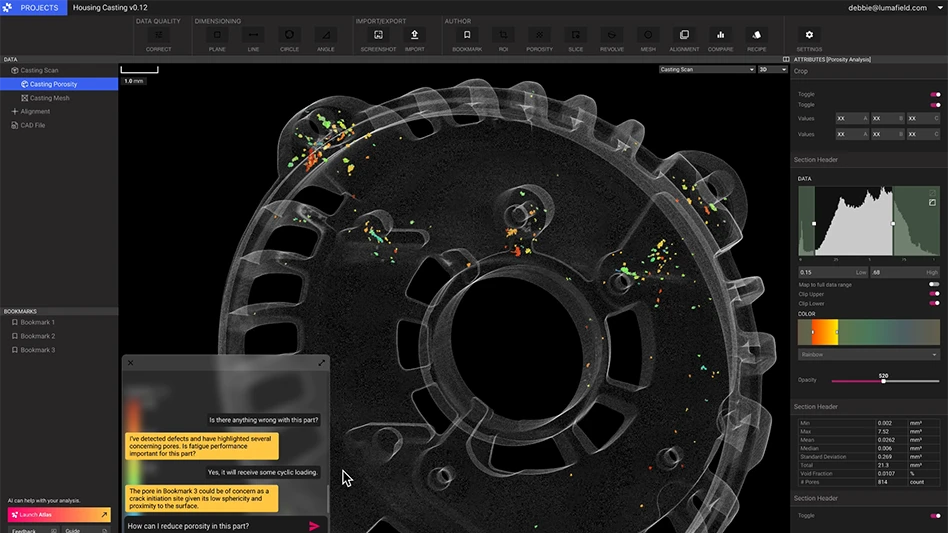
https://www.lumafield.com
Lumafield unveiled Atlas, a groundbreaking artificial intelligence (AI) co-pilot that helps engineers work faster by answering questions and solving complex engineering and manufacturing challenges using plain language.
Atlas is a new tool in Voyager, Lumafield’s cloud-based software for analyzing 3D scan and industrial CT scan data. Along with Atlas, Lumafield announced a major expansion of Voyager’s capabilities, including the ability to upload, analyze, and share data from any 3D scanner.
Atlas is an AI co-pilot for engineers that can answer engineering questions and analyze specific parts in plain language. Atlas can speed material selection, cost engineering, root cause analysis, and more.
Atlas is a new tool in Voyager, Lumafield’s cloud-based software for analyzing 3D scans and industrial CT scans. After uploading a 3D scan to Voyager, users can compare parts to their original CAD models, perform dimensional analysis, add bookmarks and comments, and share with collaborators.
Background
Engineering teams have become increasingly distributed as supply chains stretch around the world and talented professionals opt to work remotely. However, distributed engineering teams struggle with coordination, costing time and money.
Dealing with 3D scan data is particularly challenging. Although 3D scanners have become essential tools for product development and manufacturing, their software is typically limited to local PCs, blocking collaboration.
Voyager and Atlas help engineering teams work faster by facilitating the transfer of both data and expertise.
Atlas: an AI co-pilot for engineers
Using Atlas is like working alongside a seasoned engineer. In addition to answering general engineering questions, it can analyze 3D scans, pinpoint issues, and suggest solutions. Atlas speeds up work at every stage of the product development process, shaving hours from traditional engineering workflows. Atlas can suggest materials and manufacturing processes that suit specific use cases, perform cost engineering, troubleshoot problems, and perform root cause analysis.
For users who opt to share internal knowledge with Atlas, it can also collect, organize, and share key information to help teams work faster and more efficiently.
“In order to deliver the next generation of great products – from lifesaving medical devices to electric cars – engineers need to push the limits of manufacturing,” says Andreas Bastian, Lumafield’s co-founder and head of product. “However, the knowledge required to do that is locked away in siloes, among a handful of manufacturing specialists scattered around the world. Atlas gives every engineer access to a level of expertise that’s only been available to the largest and wealthiest companies – until now.”
Voyager: cloud-based analysis software for 3D scans and industrial CT scans
Atlas sits within Voyager, Lumafield’s cloud-based software for visualizing and analyzing 3D scans and industrial CT scans. Voyager was released in 2022 as a companion to Lumafield’s Neptune industrial X-ray CT scanner. Industrial CT, or computed tomography, works on the same principles as medical CT but allows engineers to inspect invisible internal features in manufactured products.
Customers have adopted Lumafield to inspect gaskets and seals on consumer packaging, mechanical assemblies in medical devices, electronic components in airbags, and stitching in high-performance athletic shoes.
As of today, Voyager now allows anyone to upload scans from any 3D scanner – not just Lumafield’s own industrial CT scanners. Users can share scans with collaborators, take dimensions, and perform comparisons between scans and between a scan and its original CAD model – all in a web browser, with no software to install.
“Over 10,000 users have signed up for Voyager to view, analyze, and collaborate on industrial X-ray CT scans, proving that engineering teams are eager to find new ways to work faster,” says Eduardo Torrealba, co-founder and CEO of Lumafield. “Voyager’s newest capabilities make it a powerful tool for every engineer who works on designing or manufacturing physical products.”
